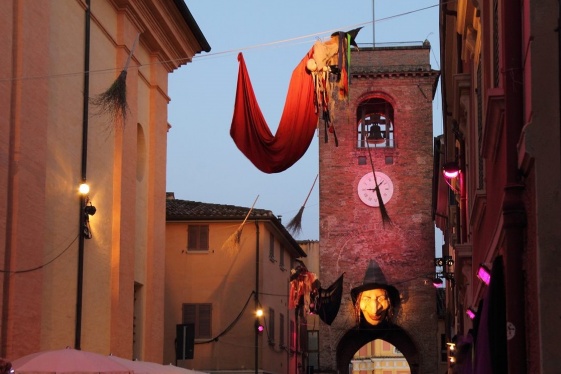
I borghi più belli d'Italia
The goal of our Club, which was not created merely as an integrated tourist promotional operation, is to guarantee - through protection, restoration, promotion and utilization - the preservation of a great heritage of monuments and memories that would otherwise be irretrievably lost. http://www.borghitalia.it/
Italian little Italies: Mel, the twin castle
At the end of the ninth century BC, going up from the plain along the Piave river, the ancient populations of Veneto arrived on this hill that seemed to them a good place to stop. The testimonies of their settlement are preserved in the Archaeological Museum: the findings coming from the necropolis, discovered in the years sixties, are datable betw...
Italian little Italies: Guardiagrele, the gateway to Maiella
You may start your visit of the old town centre from the collegiate church of Santa Maria Maggiore, built at the beginning of the thirteenth century as a cemetery church extra Moenia and become, in the following centuries, the main building of the city. The façade is characterized by a massive bell tower and a beautiful fifteenth-century portal.
Italian little Italies: Erice, the beacon of peace in the Mediterranean
It is difficult to describe the charm of Erice in just a few words. In ancient times, the mountain on which it stands was the site of the cult of a goddess of fertility, adored with the name of Astarte by the Phoenicians, who built her a temple. Aphrodite for the Greeks, for the Romans the goddess who protected sailors was Venus Ericina, the Love G...
Italian little Italies: Anghiari, between Tiber and Arno
Anghiari is a splendid Borgo overlooking the Valtiberina, the green valley of the upper Tiber River. In the middle ages, it was a very important fortified Borgo, with its strong 13th century walls and its strategic position. In the valley below, the famous Anghiari battle took place in 1440: the Florentines here defeated the Milaneses and the famou...
Italian little Italies: San Giovanni in Marignano, where the Malatesta hid the grain
Before entering the Borgo, opposite to the city tower you can admire the church of Santa Lucia. Built on an earlier century religious building in 1786, it is also dedicated to the Madonna “della Scuola”. Of the ancient church, of which the new one has maintained the architectural structure, only a fresco by an unknown author from Romagna depicting...
Italian little Italies: Albori, a white outpost of paradise
Set in a corner of Mount Falerio above the southern stretch of the rocky Amalfi coast, in the Gulf of Salerno, Albori seems suspended between the sea and the mountain. Àlbori is a miniature of the eternal appeal of the Mediterranean. A cluster of colourful houses on the sea front, leaning against each other between lanes and narrow alleyways. Const...
Italian little Italies: Montecassiano, the land of brotherhoods
The borgo of Montecassiano dominates the hill between the Monocchia river and the Potenza river. Its medieval identity is enclosed within the high walls, which still surround the old town, that were built starting from 1437, and that separate it from more recent buildings. The urban structure developed in concentric streets that followed the confor...
Italian little Italies: Venzone, a living room within the walls
Venzone, in the province of Udine, in Friuli Venezia Giulia, owes its fortune to the fact that it has been an obligatory passage to the north since the time of the Celts in 500 BC. Then the Romans made the town one of their stands along the route of the Via Julia Augusta from the site of Aquileia to Norico (now Central Austria). Such information is...
Italian little Italies: Sepino, at the crossroads of the sheep tracks
Sepino was born as a place where flocks and shepherds who travelled could stop and rest. Because of the Samnite wars, the inhabitants escaped on the mountain Terravecchia, where they built a city said by Livio to be “very strong and very powerful”; however, it was soon conquered by the Romans. They built the new city by adapting the cardo and decum...
Italian little Italies: Garbagna, Art in the hills of cherry trees
Garbagna is the most important center of Val Grue (Grue Valley). It is a medieval borgo, whose name derives from the Latin garbus, which means “bush”. The first archive news about Garbagna appear on March 29, 945: a diploma of Ugo of Provence, the king of Italyof Carolingian origin. In this document the king confers the borgo to Count Elisiardo, a...
Italian little Italies: Tremezzo, four villages between the lake and the mountains
"Finally we saw the lovely beach of Tremezzina, whose charming valleys enjoy the same climate as Rome. Those who live in Milan and suffer the cold, in fact, come here to spend the winter; there are more and more buildings on the green hills which are reflected in the lake. They can’t be called “Palaces”, but it is not enough to define them as just...
Italian little Italies: Vico del Gargano. Oranges, love and will of life
At first glance Vico seems to be poor in relation to other villages, such as Vieste and Peschici that are beautiful, clean and touristic, in the Gargano. Vico del Gargano looks like something picturesque and decadent, like classical ruins in paintings by eighteenth century landscape artists. While other places are no longer a novelty, Vico shows a...














